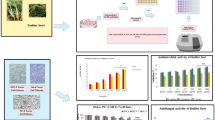Abstract
Influenza is a serious respiratory illness which can be debilitating and cause complications that lead to hospitalization and death. Although influenza vaccine can prevent influenza virus infection, the only therapeutic options to treat influenza virus infection are antiviral agents. Given temporal and geographic changes and the shifts in antiviral drug resistance among influenza viruses, it is time to consider natural antiviral agents against influenza virus. Jatropha curcas is known for various medicinal uses. Its antimicrobial, anti-cancer and anti-HIV activity has been well recognized. Because of its broad-spectrum activity, we investigated aqueous and methanol leaf extracts for cytotoxicity and its potential to inhibit hemagglutinin protein of influenza virus. The bioactive compounds from leaf extracts were characterized by high-performance thinlayer chromatography which revealed the presence of major phytochemicals including flavonoids, saponins and tannins. The cytotoxic concentration 50 for aqueous and methanol extracts were determined using trypan blue dye exclusion assay. Inhibition of hemagglutinin protein was assessed using minimal cytotoxic concentrations of the extracts and 102.5 TCID50 (64 HA titre) of the Influenza A (H1N1) virus with different exposure studies using hemagglutination assay. Aqueous and methanol extracts were found to be non toxic to Madin darby canine kidney cells below concentration of 15.57 and 33.62 mg/mL for respectively. Inhibition of hemagglutinin was studied using reducing hemagglutination titre which confirmed that the J. curcas extracts have direct effect on the process of virus adsorption leading to its inhibition. Our results provide the information which shows the potential of Jatropha extracts in the treatment of influenza A (H1N1) virus infection. With an established reduced toxicity and prevention of infection by inhibiting hemagglutinin protein, these extracts and its derivatives may be further developed as broad spectrum anti-influenza drugs for prevention and treatment of infections by different types of influenza viruses with further mechanistic studies on anti-influenza.






Similar content being viewed by others
References
Dahake RV, Roy SS, Deepak Patil DY, Chowdhary AS, Deshmukh RA. Evaluation of anti-viral activity of Jatropha curcas leaf extracts against potentially drug-resistant HIV isolates. BMC Infect Dis. 2012;12(Suppl 1):P14.
Das Gupta D, Md Enamul Haque, Md Nahidul Islam, Shakhinur Islam Md, BA Shibib. Antimicrobial and cytotoxic activities of Jatropha curcas (Euphorbiaceae). Dhaka Univ J Pharm Sci. 2010;9(2):139–42.
Dhale DA, Birari AR. Preliminary screening of antimicrobial and phytochemical studies of Jatropha gossypifolia Linn. Recent Res Sci Technol. 2010;2(7):24–8.
Ehrhardt C, Hrincius ER, Korte V. A polyphenol rich plant extract, CYSTUS052, exerts anti influenza virus activity in cell culture without toxic side effects or the tendency to induce viral resistance. Antivir Res. 2007;76(1):38–47.
Giuseppe SA, Saydam G, Banerjee D, Bertino JR. Cytotoxicity and cell growth assays. Cell Biol. 2006;38:315–24.
Igbinosa OO, Igbinosa EO, Aiyegoro OA. Antimicrobial activity and phytochemical screening of stem bark extracts from Jatropha curcas (Linn.). Afr J Pharmacol. 2009;3:58–62.
Kamps BS, Teran GR. Influenza. In: Kamps BS, Hoffmann C, Preiser W, editors. Influenza report 2006. Wuppertal: Flying Publisher; 2006. p. 17–38.
Matsuse IT, Lim YA, Hattori M, Correa M, Gupta MP. A search for anti-viral properties in Panamanian medicinal plants: the effects on HIV and its essential enzymes. J Ethnopharmacol. 1998;64:15–22.
Moshi MJ. Current and future prospects of integrating traditional and alternative medicine in the management of diseases in Tanzania. Tanzan Health Res Bull. 2005;7:159–67.
Nayak BS, Patel KN. Pharmacognostic studies of the Jatropha curcas leaves. Int J Pharm Tech Res. 2010;2(1):140–3.
Rajbhandari M, Wegner U, Schopke T, Lindequist U, Mentel R. Inhibitory effect of Bergenia ligulata on influenza virus A. Pharmazie. 2003;58(4):268–71.
Reddy Prasad DM, Izam A, Khan MR. Jatropha curcas: plant of medical benefits. J Med Plants Res. 2012;6(14):2691–9.
Reed LJ, Muench HA. A simple method of estimating fifty percent endpoints. Am J Hyg. 1938;27:493–7.
Ryu YB, Curtis-Long MJ, Kim JH. Pterocarpans and flavanones from Sophora flavescens displaying potent neuraminidase inhibition. Bioorg Med Chem Lett. 2008;18(23):6046–9.
Serkedjieva J, Manolova N. Plant polyphenolic complex inhibits the reproduction of influenza and herpes simplex viruses. Phytother Res. 1999;10(5):441–3.
Song JM, Lee KH, Seong BL. Antiviral effect of catechins in green tea on influenza virus. Antivir Res. 2005;68:66–74.
Sriprang S, Sriprang N, Sumpradit T, Shimbhu D. Antibacterial activities of crude extracts from physic nut (Jatropha curcas) seed residues. Sci Asia. 2010;36:346–8.
Thomas R, Sah NK, Sharma PB. Therapeutic biology of Jatropha curcas: a mini review. Curr Pharm Biotechnol. 2008;9:315–24.
Wirotesangthong M, Nagai T, Yamada H, Amnuoypol S, Mungmee C. Effects of Clinacanthus siamensis leaf extract on influenza virus infection. Microbiol Immunol. 2009;53(2):66–74.
Yingsakmongkon S, Miyamoto D, Sriwilaijaroen N. In vitro inhibition of human influenza A virus infection by fruit-juice concentrate of Japanese plum (Prunus mume SIEB.et ZUCC). Biol Pharm Bull. 2008;31(3):511–5.
Acknowledgments
We are grateful to Dr. (Mrs). M. S. Chadha, Assistant Director, Influenza group, National Institute of Virology, Pune, Maharashtra, India for providing us Influenza virus strain.
Author information
Authors and Affiliations
Corresponding author
Rights and permissions
About this article
Cite this article
Patil, D., Roy, S., Dahake, R. et al. Evaluation of Jatropha curcas Linn. leaf extracts for its cytotoxicity and potential to inhibit hemagglutinin protein of influenza virus. Indian J. Virol. 24, 220–226 (2013). https://doi.org/10.1007/s13337-013-0154-z
Received:
Accepted:
Published:
Issue Date:
DOI: https://doi.org/10.1007/s13337-013-0154-z




